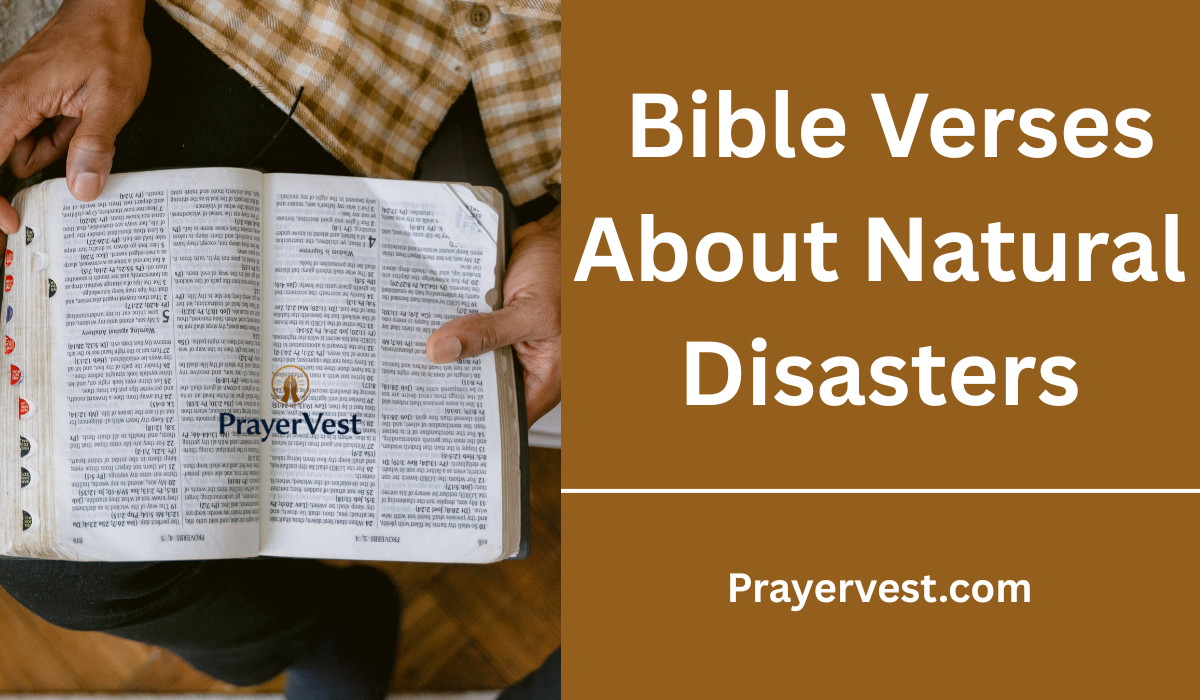Natural catastrophes, such as earthquakes, floods, storms, fires, and famines, can leave people feeling lost, afraid, and with unsolved problems. The Bible offers guidance, consolation, and a heavenly viewpoint in the face of these powerful forces rather than ignoring these facts of reality.
Natural disasters are described in Genesis through Revelation as both reminders of God’s omnipotence and our reliance on Him. These verses serve as a reminder that God maintains His sovereignty despite creation’s groaning, giving those who believe in Him courage and hope.
Natural catastrophes are frequently cited in the Bible as examples of God’s power, justice, and occasionally His demand for repentance. But in addition to these acts of might, the Bible also shows God’s compassion, as He promises to provide His people with safety and support throughout difficult times.
The earth may be shaken by natural disasters, but God’s unwavering love remains unshaken. These verses act as pillars of trust for believers, reassuring us that even during life’s storms, God’s purposes are always in motion.


Bible texts about natural disasters provide us with eternal lessons about faith, resiliency, and divine care in addition to historical context. In times of uncertainty, these verses exhort us to look to God for protection, consolation, and direction. These passages prepare us to react with confidence rather than fear, whether they serve as cautions, reminders of human weakness, or guarantees of God’s dependable presence. God’s Word reassures us that His mercy and strength remain our ultimate refuge in a world where disasters are unavoidable.
40 Powerful Bible Verses About Natural Disasters (2025)
1. Genesis 7:11
“On that day all the springs of the great deep burst forth, and the floodgates of the heavens were opened.”
This verse recalls the beginning of the great flood during Noah’s time, where the natural elements responded to God’s judgment upon the earth. The imagery of the deep bursting forth and the heavens opening shows how even creation itself can serve as an instrument of God’s will. It reminds us that natural disasters, while devastating, can also be moments of divine intervention, calling humanity back to repentance and obedience.
2. Exodus 9:23
“When Moses stretched out his staff toward the sky, the Lord sent thunder and hail, and lightning flashed down to the ground. So the Lord rained hail on the land of Egypt.”
This passage describes one of the plagues of Egypt, where a natural disaster—hail mixed with fire—was used to demonstrate God’s power and authority over Pharaoh and his gods. The event shows that God can command nature to carry out His purposes, both for judgment and for deliverance. It reveals that even the fiercest storms are under His control and serve as reminders of His sovereignty.
3. Psalm 46:2-3
“Therefore we will not fear, though the earth give way and the mountains fall into the heart of the sea, though its waters roar and foam and the mountains quake with their surging.”
In these verses, the psalmist acknowledges the terrifying reality of natural disasters—earthquakes, floods, and roaring seas—yet declares unwavering trust in God. This passage reminds believers that even when creation trembles, God remains a refuge and strength. It encourages faith and courage in the face of chaos, offering assurance that His presence is greater than the turmoil of the natural world.
4. Amos 4:13
“He who forms the mountains, who creates the wind, and who reveals his thoughts to mankind, who turns dawn to darkness, and treads on the heights of the earth—the Lord God Almighty is his name.”
Here, the prophet Amos proclaims the power and majesty of God, the Creator of natural forces such as wind and darkness. This verse highlights that the same God who forms the earth can also allow or restrain disasters according to His will. It teaches us to view natural events not as random occurrences, but as reminders of God’s supremacy over creation.
5. Nahum 1:3
“The Lord is slow to anger but great in power; the Lord will not leave the guilty unpunished. His way is in the whirlwind and the storm, and clouds are the dust of his feet.”
This verse paints a picture of God’s presence in the forces of nature—whirlwinds, storms, and clouds. While God is patient and merciful, He is also powerful and just. Natural disasters here are symbolic of His strength and His ability to bring justice. It reminds us that even in the most terrifying natural events, God’s presence is not absent, but often speaks through them.
6. Jonah 1:4
“Then the Lord sent a great wind on the sea, and such a violent storm arose that the ship threatened to break up.”
In Jonah’s story, the storm was not random but divinely orchestrated to turn Jonah back from disobedience. This verse shows how God can use natural disasters as instruments of correction, redirecting people toward His will. It illustrates that storms, while destructive, can also become opportunities for repentance, obedience, and realignment with God’s plan.
7. Matthew 8:26
“He replied, ‘You of little faith, why are you so afraid?’ Then he got up and rebuked the winds and the waves, and it was completely calm.”
This New Testament passage demonstrates Jesus’ authority over natural disasters. By calming the storm with a word, He reveals His divine power as Lord over creation. For believers, this story reassures us that even when the winds and waves of life feel overwhelming, Jesus is present, able to command peace and bring calm to chaos.
8. Luke 21:11
“There will be great earthquakes, famines and pestilences in various places, and fearful events and great signs from heaven.”
Jesus warns of natural disasters and global turmoil as signs of the end times. This verse emphasizes both the reality and the spiritual significance of disasters. They are not meant to incite fear, but to prepare believers for endurance and hope in God’s ultimate plan of redemption. It teaches vigilance, faith, and readiness in the face of global uncertainty.
9. Revelation 6:12
“I watched as he opened the sixth seal. There was a great earthquake. The sun turned black like sackcloth made of goat hair, the whole moon turned blood red.”
In Revelation, natural disasters are portrayed as part of the unfolding of God’s final judgment. Earthquakes, eclipses, and cosmic disturbances symbolize the shaking of creation itself under God’s authority. This verse reminds us that disasters can be part of God’s prophetic timeline, urging humanity to repentance and faith before the final day of the Lord.
10. Mark 13:8
“Nation will rise against nation, and kingdom against kingdom. There will be earthquakes in various places, and famines. These are the beginning of birth pains.”
Here, Jesus describes disasters as part of the “birth pains” leading up to His return. The imagery of birth pains suggests both suffering and the hope of something new. Natural disasters, though tragic, are reminders of a broken world awaiting redemption. For believers, this verse encourages endurance and faith, knowing that God’s kingdom will come in fullness after the storms.
11. Isaiah 29:6
“The Lord Almighty will come with thunder and earthquake and great noise, with windstorm and tempest and flames of a devouring fire.”
This verse highlights how God can use natural elements like earthquakes, storms, and fire to demonstrate His power. These overwhelming forces of nature serve as reminders of His majesty and authority. While they may strike fear in human hearts, they also affirm that nothing in creation is beyond God’s control.
12. Jeremiah 10:13
“When he thunders, the waters in the heavens roar; he makes clouds rise from the ends of the earth. He sends lightning with the rain and brings out the wind from his storehouses.”
Jeremiah reminds us that all natural occurrences, from rain to lightning, are directed by God’s hand. This verse teaches that storms are not random acts of chaos but part of God’s creation and order. Even in disasters, His sovereign will is at work, revealing both His might and His role as Creator.
13. Ezekiel 38:19
“In my zeal and fiery wrath I declare that at that time there shall be a great earthquake in the land of Israel.”
Here, God declares His judgment through an earthquake, showing how natural disasters can serve as instruments of divine justice. The shaking of the earth symbolizes God’s anger against sin and His power to disrupt human security. It reminds us of the seriousness of turning away from God’s will.
14. Haggai 2:6
“This is what the Lord Almighty says: ‘In a little while I will once more shake the heavens and the earth, the sea and the dry land.’”
This prophecy speaks of God shaking both heaven and earth as a sign of His power and coming glory. Disasters and upheavals remind us that human kingdoms are temporary, but God’s kingdom is eternal. It is a call to place our trust in the unshakable foundation of God’s promises.
15. Job 37:9-10
“The tempest comes out from its chamber, the cold from the driving winds. The breath of God produces ice, and the broad waters become frozen.”
Job’s poetic reflection reveals God’s role in directing storms, winds, and even the cold. Natural events, whether destructive or calming, are seen as expressions of His breath. This passage teaches us that disasters are not beyond His design, and they often call us to humility and reverence.
16. Psalm 18:7
“The earth trembled and quaked, and the foundations of the mountains shook; they trembled because he was angry.”
David poetically describes God’s anger expressed through an earthquake, symbolizing His mighty response to injustice. The trembling earth reflects God’s deep involvement in the affairs of humanity. This verse reveals that disasters, while terrifying, can also point to God’s passionate concern for righteousness.
17. Psalm 97:4-5
“His lightning lights up the world; the earth sees and trembles. The mountains melt like wax before the Lord, before the Lord of all the earth.”
These verses vividly portray God’s majesty displayed in natural forces. Lightning, trembling earth, and melting mountains symbolize His unmatched authority. It reminds us that no matter how stable creation may seem, it bows before the power of the Lord.
18. Isaiah 24:19-20
“The earth is broken up, the earth is split asunder, the earth is violently shaken. The earth reels like a drunkard, it sways like a hut in the wind; so heavy upon it is the guilt of its rebellion that it falls—never to rise again.”
Isaiah describes a dramatic picture of the earth shaking under the weight of sin and rebellion. Natural disasters here are tied to human sin and God’s judgment. This passage reminds us that creation itself groans under the burden of human disobedience, awaiting restoration through God’s redemption.
19. Revelation 16:18
“Then there came flashes of lightning, rumblings, peals of thunder and a severe earthquake. No earthquake like it has ever occurred since mankind has been on earth, so tremendous was the quake.”
This apocalyptic vision shows an unprecedented natural disaster as part of God’s final judgment. The description emphasizes both the magnitude of the event and God’s unmatched power. It underscores that even the strongest forces of nature are part of His divine plan.
20. Matthew 24:7
“Nation will rise against nation, and kingdom against kingdom. There will be famines and earthquakes in various places.”
Jesus again reminds His disciples that disasters are part of the signs of the times. They serve as wake-up calls, urging believers to remain steadfast in faith. This verse highlights the importance of spiritual readiness amidst the uncertainty of natural and global turmoil.
21. Acts 16:26
“Suddenly there was such a violent earthquake that the foundations of the prison were shaken. At once all the prison doors flew open, and everyone’s chains came loose.”
This passage records a miraculous event in which God used an earthquake not as destruction, but as deliverance. Paul and Silas, imprisoned for their faith, experienced God’s power through the trembling of the earth. The shaking broke chains and opened doors, symbolizing both physical and spiritual freedom. It reminds us that while disasters often cause fear and ruin, God can also use them as instruments of liberation, turning calamity into a testimony of His glory. In our own lives, the “earthquakes” we face may break away the chains of sin, fear, or oppression, creating opportunities for God’s intervention and renewal.
22. Isaiah 30:30
“The Lord will cause people to hear his majestic voice and will make them see his arm coming down with raging anger and consuming fire, with cloudburst, thunderstorm and hail.”
Isaiah portrays natural disasters as vivid demonstrations of God’s voice and power. Thunderstorms, hail, and fire serve as signs of His authority over creation and His judgment against sin. While such imagery can seem terrifying, it also assures believers that God is not distant from the storms of life. Instead, He uses them to reveal His presence and call people back to Him. This verse encourages us to interpret even the fiercest trials not as abandonment, but as opportunities to hear His “majestic voice” calling us to deeper faith and reverence.
23. Psalm 29:3-4
“The voice of the Lord is over the waters; the God of glory thunders, the Lord thunders over the mighty waters. The voice of the Lord is powerful; the voice of the Lord is majestic.”
The psalmist poetically describes God’s voice as thunder over mighty waters, equating the power of natural storms to His glory. Storms that shake the seas remind us of God’s majesty and the awe that creation inspires. This passage reveals that natural forces, while frightening, also echo divine power and presence. For believers, hearing thunder or watching raging waters can become moments of worship, as we remember that the Creator rules over the elements. It shifts our perspective from fear to reverence, reminding us that God’s voice is mightier than any storm we encounter.
24. Joel 2:30-31
“I will show wonders in the heavens and on the earth, blood and fire and billows of smoke. The sun will be turned to darkness and the moon to blood before the coming of the great and dreadful day of the Lord.”
Joel speaks of cosmic disturbances and terrifying natural signs that precede the day of the Lord. Disasters, here, are tied not just to earthly chaos but to the unfolding of God’s redemptive plan. These signs remind humanity of both God’s justice and His coming restoration. While frightening, they also prepare believers to look beyond the temporary to the eternal. In today’s context, natural and cosmic events can remind us of our dependence on God and the urgency of living faithfully, knowing that His kingdom is drawing near.
25. Psalm 107:25-29
“For he spoke and stirred up a tempest that lifted high the waves. They mounted up to the heavens and went down to the depths; in their peril their courage melted away… Then they cried out to the Lord in their trouble, and he brought them out of their distress. He stilled the storm to a whisper; the waves of the sea were hushed.”
This psalm portrays sailors facing a fierce storm, overwhelmed by towering waves. Their fear led them to cry out to God, and He answered by calming the seas. This passage illustrates both God’s sovereignty in allowing the storm and His compassion in delivering His people. Natural disasters can strip away human pride, reminding us of our vulnerability. Yet they also teach us to turn to God as our ultimate rescuer. This scripture encourages us to cry out in times of crisis, trusting that the same God who calmed the seas still responds to our desperate prayers.
26. Habakkuk 3:10
“The mountains saw you and writhed. Torrents of water swept by; the deep roared and lifted its waves on high.”
Habakkuk paints a dramatic image of nature responding to the presence of God. Mountains tremble, rivers surge, and the sea roars—all symbolizing God’s overwhelming power. This verse portrays disasters not as random chaos but as creation trembling before its Maker. It challenges us to view disasters as reminders that we live in a world under God’s authority. When life feels unstable and everything seems to “writhe” around us, we can take comfort knowing that God remains sovereign over creation and history alike.
27. Revelation 11:19
“Then God’s temple in heaven was opened, and within his temple was seen the ark of his covenant. And there came flashes of lightning, rumblings, peals of thunder, an earthquake and a severe hailstorm.”
This apocalyptic vision ties natural disasters directly to the unveiling of God’s presence. Lightning, thunder, earthquakes, and hailstorms accompany the revealing of the ark of the covenant, symbolizing divine holiness and authority. Such imagery reminds us that disasters are not only earthly events but can also signify spiritual realities. It calls believers to prepare their hearts for the day when God’s kingdom is fully revealed, and to find assurance that His covenant faithfulness endures even amid the storms.
28. Isaiah 13:13
“Therefore I will make the heavens tremble; and the earth will shake from its place at the wrath of the Lord Almighty, in the day of his burning anger.”
Here, Isaiah speaks of a day when both heaven and earth will tremble under God’s judgment. The shaking represents not just physical instability but the unraveling of human pride and rebellion. Natural disasters become symbols of God’s wrath against sin, reminding us of the seriousness of rejecting His ways. Yet within this imagery lies a deeper hope: after the shaking comes renewal, as God brings justice and restoration. It calls us to repentance and reverence, living in alignment with His will.
29. Matthew 7:25
“The rain came down, the streams rose, and the winds blew and beat against that house; yet it did not fall, because it had its foundation on the rock.”
Though not describing a literal disaster, this verse uses imagery of storms and floods to teach a spiritual truth. Life’s disasters—both natural and personal—test the foundations on which we build. Those who anchor themselves on Christ, the Rock, stand firm even when storms rage. This passage assures us that though disasters may come, a life built on faith in Jesus will not collapse. It challenges us to examine our foundations, ensuring that they are rooted in eternal truth rather than temporary security.
30. Luke 8:24
“The disciples went and woke him, saying, ‘Master, Master, we’re going to drown!’ He got up and rebuked the wind and the raging waters; the storm subsided, and all was calm.”
This verse captures another moment of Jesus calming a storm, showing His lordship over creation. The disciples, filled with fear, thought disaster would claim their lives, but Jesus demonstrated that no storm is beyond His control. For us today, this story reminds us that panic and fear often cloud our faith, yet Christ is always present to bring calm. It teaches us to invite Him into our storms, whether physical disasters or personal crises, and trust His authority to restore peace.
31. Job 9:5-6
“He moves mountains without their knowing it and overturns them in his anger. He shakes the earth from its place and makes its pillars tremble.”
Job describes the sheer force of God’s power as seen in creation’s upheaval—mountains overturned and the earth shaken. These images show that disasters, though frightening, reflect God’s supreme authority over the world. It challenges us to see beyond the chaos and recognize His sovereignty. Disasters remind us of our human frailty but also point to the greatness of God, who governs even the most powerful forces of nature.
32. Isaiah 2:19
“People will flee to caves in the rocks and to holes in the ground from the fearful presence of the Lord and the splendor of his majesty, when he rises to shake the earth.”
Isaiah paints a sobering picture of humanity fleeing in terror during times when God shakes the earth. Natural disasters here symbolize divine judgment, compelling people to recognize God’s majesty. It reveals that human strength and pride cannot stand against the presence of the Almighty. For believers, this verse is a call to humility and reverence, finding shelter not in caves or earthly defenses but in the Lord Himself.
33. Psalm 114:7
“Tremble, earth, at the presence of the Lord, at the presence of the God of Jacob.”
This psalm captures the earth’s trembling response to God’s presence. Natural disasters, while often destructive, can also be seen as creation acknowledging the power of its Maker. It is a reminder that the world is not governed by random chance but by the Creator’s will. For believers, this verse teaches us to live with reverence, recognizing that the same God who makes the earth tremble is also our refuge and strength.
34. Hebrews 12:26-27
“At that time his voice shook the earth, but now he has promised, ‘Once more I will shake not only the earth but also the heavens.’ The words ‘once more’ indicate the removing of what can be shaken—that is, created things—so that what cannot be shaken may remain.”
Here, the writer of Hebrews reflects on God’s shaking of creation as a way of stripping away what is temporary and leaving what is eternal. Natural disasters serve as reminders that earthly security is fragile. What endures is the unshakable kingdom of God. This passage calls us to anchor our lives in Christ, knowing that while the world may tremble, His promises remain firm.
35. Jonah 2:3
“You hurled me into the depths, into the very heart of the seas, and the currents swirled about me; all your waves and breakers swept over me.”
Jonah recounts his terrifying experience of being thrown into the sea, overwhelmed by waves and currents. His words capture the fear of drowning in the chaos of nature. Yet even in that place, Jonah recognized God’s hand at work. This verse teaches us that no matter how deep the waters or strong the storms, God’s presence is still near. It encourages us to call out to Him in our darkest, most desperate moments.
36. Micah 1:3-4
“Look! The Lord is coming from his dwelling place; he comes down and treads on the heights of the earth. The mountains melt beneath him and the valleys split apart, like wax before the fire, like water rushing down a slope.”
Micah portrays God’s coming with vivid images of melting mountains and splitting valleys, echoing the violence of natural disasters. These images remind us of God’s authority to humble creation and humanity alike. While terrifying, they also affirm His presence and justice. For believers, they call us to prepare our hearts for the Lord’s coming, ensuring we stand firm in His grace when the world shakes around us.
37. Psalm 18:12-13
“Out of the brightness of his presence clouds advanced, with hailstones and bolts of lightning. The Lord thundered from heaven; the voice of the Most High resounded.”
David describes a storm as a revelation of God’s majesty—hail, lightning, and thunder symbolizing His power. Natural disasters are not random events but reminders of God’s authority and might. This verse encourages us to see storms not only as threats but also as testimonies of the God who reigns above creation. They point us toward awe, worship, and trust in His protection.
38. Ezekiel 38:22
“I will execute judgment on him with plague and bloodshed; I will pour down torrents of rain, hailstones and burning sulfur on him and on his troops and on the many nations with him.”
Here God declares His judgment through torrents of rain, hailstones, and sulfur, using natural disasters as weapons of justice. It reveals that creation itself can act as an instrument of divine will. This passage reminds us that God’s sovereignty extends to both blessing and judgment. For the faithful, it is a call to walk in righteousness, knowing that the God who commands the storm is also our protector.
39. Revelation 8:5
“Then the angel took the censer, filled it with fire from the altar, and hurled it on the earth; and there came peals of thunder, rumblings, flashes of lightning and an earthquake.”
This apocalyptic vision links heavenly events with earthly disasters—thunder, lightning, and earthquakes as signs of divine action. It reminds us that natural disasters can signify more than physical upheaval; they point to spiritual realities. For believers, it underscores the urgency of living faithfully, knowing that God’s kingdom is advancing, and His justice will be revealed.
40. Psalm 104:32
“He who looks at the earth, and it trembles, who touches the mountains, and they smoke.”
This psalm beautifully yet powerfully describes God’s intimate control over creation—the earth trembles at His gaze, and mountains smoke at His touch. Disasters, then, are not signs of absence but of His presence and power. This verse reminds us that creation is fully subject to Him. In times of calamity, we can take comfort in knowing that the same God who commands the trembling earth also upholds us with His care.
Conclusion
The Bible teaches us that even if the earth trembles and creation moans during natural disasters, God is unwavering and sovereign. According to His Word, He is our stronghold, our haven, and the one who can tame even the most ferocious storms. In addition to offering consolation during difficult times, these passages exhort us to firmly establish our confidence in the One who is in control of the cosmos. Scripture serves as a reminder that God is always present, His promises are enduring, and His love is unfailing, regardless of natural disasters like earthquakes, floods, hurricanes, or wildfires.
In the end, natural catastrophes serve as a reminder of the transience of existence and the necessity of having faith in God’s everlasting purpose. Scripture exhorts us to pray to Him, ask for His protection, and find rest in His calm despite the chaos all around us. We can face uncertainty with optimism when we rely on God’s Word because we know that He is our refuge in times of storm and that His power will always win out.






